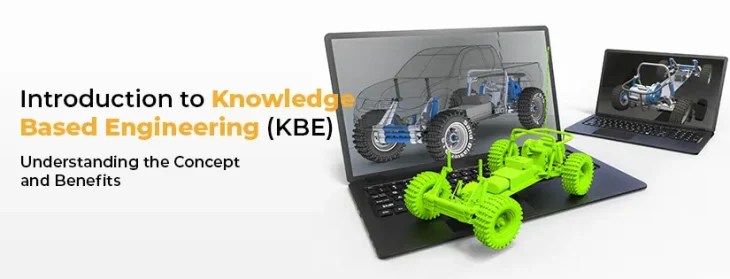Customer Login
Introduction to Knowledge-Based Engineering (KBE) – Understanding the Concept and Benefits
- Home
- Blog Details

- April 18 2023
- admin
Table of content
Introduction
What is Knowledge Based Engineering?
The Knowledge Based Engineering Process
- Knowledge acquisition
- Knowledge modelling
- Knowledge integration
- Knowledge validation
- KBE system deployment
- KBE system maintenance
Benefits of Knowledge Based Engineering
- Increased efficiency
- Improved quality
- Reduced costs
- Enhanced collaboration
- Faster product development
- Increased innovation
- Improved decision-making
- Better documentation
- Improved customer satisfaction
Conclusion
Introduction
The world of technology is rapidly evolving, with the latest developments occurring constantly. From automation to preference-based customisation, multiple upgrades in the field of engineering are helping companies deliver better and more efficient products to customers. One such development is the increasing use of Knowledge Based Engineering methodology.
In the simplest terms, Knowledge Based Engineering is referred to the combination of artificial intelligence (AI), object-oriented programming, and CAD automation (computer-aided design). In this article, we have curated the complete details for you to understand the concept and benefits of KBE.
What is Knowledge Based Engineering?
Knowledge Based Engineering (KBE) is the latest engineering methodology that uses a computer-based system to gather, analyse, and use engineering knowledge to design and develop new products. This methodology has revolutionised the engineering industry by offering a more efficient and effective way of creating products.
Based on scientific methods and proven technology, this allows automation and customisation of the product design to speed up the process and give better and more efficient results. It eliminates the need for repetitive design work by using design automation, allowing engineers to focus on more complex and creative aspects of the design process.
Typically, KBE systems have two components: a knowledge base and a reasoning engine. The knowledge base includes the laws, knowledge figures, and models defining the engineering problem’s domain, and the reasoning engine uses this information to provide conclusions and solutions.
KBE has been applied in various industries, including aerospace, automotive, defence, and healthcare. KBE systems include a user interface, a choice of inference rules, and a knowledge base. Data on product design, technical concepts, and production procedures are stored in the knowledge base.
The Knowledge Based Engineering Process
Often used in place of CAD customisation or CAD automation, the KBE process is entirely based on knowledge acquisition and use. The process involves the steps as follows:
1.Knowledge acquisition
Collect knowledge from subject matter experts, books, journals, and other sources, then organise it so a computer can process it.
2.Knowledge modelling
Use a knowledge representation language, such as rule-based systems or semantic networks, to model the learned information and determine the connections between the data and the rules that describe the engineering domain.
3.Knowledge integration
Include the modelled knowledge in a KBE system with a knowledge base and reasoning engine, and store the knowledge there systematically.
4.Knowledge validation
Test the KBE system against well-known solutions to validate it and ensure it generates accurate and trustworthy results.
5.KBE system deployment
Install the KBE system that has been validated and instruct engineers on how to use it. Improve efficiency and quality by integrating the system into current engineering procedures.
6.KBE system maintenance
Maintaining the KBE system on an ongoing basis will ensure its effectiveness. This will involve tracking its operation, updating the knowledge base and reasoning engine, and considering user feedback. Knowing the benefits of Knowledge-Based Engineering is equally important when you want to implement it to gain extended-duration benefits.
Benefits of Knowledge Based Engineering
Knowledge-Based Engineering system has multiple benefits, which are discussed below:
Increased efficiency
KBE automates time-consuming, repetitive procedures, cutting the time and effort needed to complete engineering jobs.
Improved quality
Improved qualityKBE offers an organised method for engineering, which reduces errors and raises the calibre of the finished product.
Reduced costs
KBE can aid in lowering the cost of engineering activities by automating procedures and enhancing quality.
Enhanced collaboration
KBE makes it easier for engineering teams to collaborate and communicate, allowing them to exchange best practices and information.
Faster product development
By automating design and analysis tasks and shortening the prototyping process, KBE helps quicken product development cycles.
Increased innovation
KBE may promote innovation by enabling engineers to explore more innovative solutions and giving them access to a wider variety of design and analysis tools.
Improved decision-making
KBE can help decision-making by giving engineers access to more precise and trustworthy data and analysis results.
Better documentation
By automatically gathering and arranging engineering knowledge and data, KBE can help enhance documentation by lowering the possibility of data loss or improper management.
Improved customer satisfaction
KBE can increase customer satisfaction by speeding up product development, cutting costs, and raising product standards.
Conclusion
Knowledge Based Engineering (KBE) is a mentality emphasising the value of knowledge and experience in engineering, not merely a technology or tool. KBE helps engineers be more productive, inventive, and successful while reducing the risk of mistakes and delays by fusing human knowledge with artificial intelligence.
We at PreScient are dedicated to assisting businesses of all sizes and sectors in realising the full potential of KBE since it is the future of engineering. Whether you’re just getting started with KBE or hoping to advance your skills, our team of professionals can offer the advice, resources, and assistance you require to succeed. To find out more, call us right away.
- adminhttps://www.pre-scient.com/us/author/webwideit/
- adminhttps://www.pre-scient.com/us/author/webwideit/
- adminhttps://www.pre-scient.com/us/author/webwideit/
- adminhttps://www.pre-scient.com/us/author/webwideit/